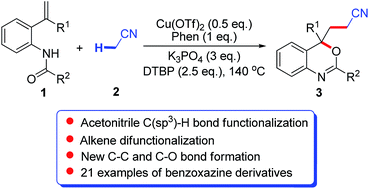Synthesis of functionalized benzoxazines by copper-catalyzed C(sp3)–H bond functionalization of acetonitrile with olefinic amides†
Abstract
A copper-mediated oxycyanomethylation reaction of olefinic amides with acetonitrile was developed for the synthesis of important benzoxazine derivatives. The reactions involve the activation of the C(sp3)–H bond of acetonitrile and radical cyclization processes for the construction of new C–C and C–O bonds.


 Please wait while we load your content...
Please wait while we load your content...